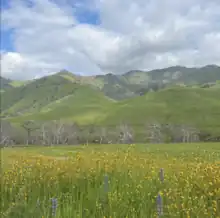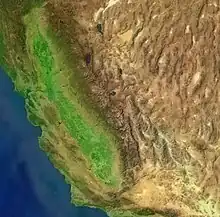

Sycamore Alluvial Woodland is a rare open woodland plant community, or vegetation type, dominated by California sycamore Platanus racemosa, existing only in small parts of California.[1]: 115 It exists only in small areas of California in the foothills of the southern Sierra Nevada range and the California Coastal Range.[1]: 115 It is rare as a plant community, even though California sycamore is a common component of other vegetation types where it is not dominant.[1]: 115 It exists at the base of flat valleys having deep alluvial gravel, where water from the hills hit the flat valley floor having an intermittent stream and large seasonal fluctuations in the water table.[1]: 115 It is a habitat type defined by broad-leafed woodland and stable levels of groundwater.[2] Sycamore Alluvial Woodland is identifiable through open savanna riparian structures, with wide floodplains.[3]
Geography
Loss of habitat over the past two centuries has greatly limited the ability of sycamore alluvial woodlands to distribute and regenerate. Changes in sediment and flow levels due to dams have likely caused its diminishing presence.[4] Only 17 habitats have been mapped along streams in California with a total recorded area of 2000 acres.[4] Due to its rarity and its susceptibility to influence by human modifications, Sycamore Alluvial Woodland is a priority for many conservationists.
Ecology
Fauna
Sycamore Alluvial Woodlands are home to a variety of vulnerable wildlife species, such as Actinemys marmorata (Western Pond Turtles) and Oncorhynchus mykiss (Rainbow Trout).[5] These habitats provide adequate nesting and roosting conditions for a plethora of bird species and additionally providing large quantities of insect and seed due to significant amounts of dead wood that make it a preferred habitat for bird diets.[4]
References
- 1 2 3 4 Introduction to California Plant Life, Robert Ornduff, Phyllis M. Faber, Todd Keeler-Wolf, California Natural History Guides No. 69, University of California Press, Ltd., 2003, ISBN 978-0-520-23704-9
- ↑ San Francisco Estuary Institute-Aquatic Science Center and H.T. Harvey & Associates. 2017. Sycamore Alluvial Woodland: Habitat Mapping and Regeneration Study. Prepared for the California Department of Fish and Wildlife Local Assistance Grant Program. A Report of SFEIASC’s Resilient Landscapes Program and H.T. Harvey & Associates, Publication # 816, San Francisco Estuary Institute, Richmond, CA.
- ↑ Grossinger, Robin M.; Striplen, Charles J.; Askevold, Ruth A.; Brewster, Elise; Beller, Erin E. (2007-07-14). "Historical landscape ecology of an urbanized California valley: wetlands and woodlands in the Santa Clara Valley". Landscape Ecology. 22 (1): 103. doi:10.1007/s10980-007-9122-6. ISSN 1572-9761. S2CID 29657.
- 1 2 3 San Francisco Estuary Institute-Aquatic Science Center and H.T. Harvey & Associates. 2017. Sycamore Alluvial Woodland: Habitat Mapping and Regeneration Study. Prepared for the California Department of Fish and Wildlife Local Assistance Grant Program. A Report of SFEIASC’s Resilient Landscapes Program and H.T. Harvey & Associates, Publication # 816, San Francisco Estuary Institute, Richmond, CA.
- ↑ Grossinger, Robin M.; Striplen, Charles J.; Askevold, Ruth A.; Brewster, Elise; Beller, Erin E. (2007-07-14). "Historical landscape ecology of an urbanized California valley: wetlands and woodlands in the Santa Clara Valley". Landscape Ecology. 22 (1): 103. doi:10.1007/s10980-007-9122-6. ISSN 1572-9761. S2CID 29657.